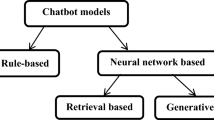Abstract
The use of conversational agents is recognized as a significant technological achievement that makes use of recent advances in machine learning and processing of natural languages. These “agents” which are considered to be computer programs enable effortless communication with users in natural language. Conversational bots have a lot of potential thanks to the recent integration of the processing of natural languages and artificial intelligence. In order to create an intelligent conversational bot, this research paper delves deeply into the incorporation of deep learning techniques. The implementation of a sequence-to-sequence simulation strengthened by a structure consisting of encoders and decoders is the main focus. A long-short cell memory recurrent neural network occupies the focal point of this architecture. The encoder facet is in charge of understanding user inquiries, and the decoder facet produces appropriate responses, resulting in an expert conversational system.
Access this chapter
Tax calculation will be finalised at checkout
Purchases are for personal use only
Similar content being viewed by others
References
L Sun J Wu Y Xu Y Zhang 2023 A federated learning and blockchain framework for physiological signal classification based on continual learning Inf Sci 630 February 586 598 https://doi.org/10.1016/j.ins.2023.02.003
Khan S, Rizwan A, Nawaz A, Ali M, Ahmed R, Hyuen D (2023) A multi-perspective revisit to the optimization methods of neural architecture search and hyper-parameter optimization for non-federated and federated learning environments. Comput Elect Eng 10:108867. https://doi.org/10.1016/j.compeleceng.2023.108867
Chin-Teng L, Mukesh P, Chia-Hsin C, Deepak P, Hesham ES, Sharmi S, Yu-Kai W, Arun Kumar S (2017) IoT-based wireless polysomnography intelligent system for sleep monitoring. IEEE Access 6
Saurabh K, Pathak SK (2022) A comprehensive study of XSS attack and the digital forensic models to gather the evidence. ECS Trans 107(1)
Shachi M (2023) Heart diagnosis using deep neural network. In: Accepted in 3rd international conference on computational intelligence and knowledge economy ICCIKE 2023, Amity University, Dubai
Singh J (2022) An efficient deep neural network model for music classification. Int J Web Sci 3(3)
Vijay Kumar B (2021) Neural network model for recommending music based on music genres. In: 10th IEEE international conference on computer communication and informatics (ICCCI -2021), Jan. 27–29, Coimbatore, INDIA
Aditi S (2017) Term co-occurrence and context window based combined approach for query expansion with the semantic notion of terms. Int J Web Sci (IJWS) Indersci 3(1)
Xu H, Nanda P, Liang J, He X (2023) FCH, an incentive framework for data-owner dominated federated learning. J Inf Secur Appl 76:103521. https://doi.org/10.1016/j.jisa.2023.103521
S Rani A Kataria S Kumar P Tiwari 2023 Federated learning for secure IoMT-applications in smart healthcare systems: a comprehensive review Knowl Based Syst 274 110658https://doi.org/10.1016/j.knosys.2023.110658
CS Yadav A Yadav HS Pattanayak R Kumar AA Khan MA Haq A Alhussen S Alharby 2022 Malware analysis in IoT & android systems with defensive mechanism Electronics 11 2354 https://doi.org/10.3390/electronics11152354
Upreti K, Gupta AK, Dave N, Surana A, Mishra D (2022) Deep learning approach for hand drawn emoji identification. In: 2022 IEEE international conference on current development in engineering and technology (CCET), Bhopal, India, pp 1–6. https://doi.org/10.1109/CCET56606.2022.10080218
Mohammad Sajid, Ranjit Rajak,” Capacitated Vehicle Routing Problem Using Algebraic Particle Swarm Optimization with Simulated Annealing Algorithm”, In Artificial Intelligence in Cyber-Physical Systems, CRC Press, 2023.
Aruna Y, Kumar A (2022) A review of physical unclonable functions (PUFs) and its applications in IoT environment. In: Hu YC, Tiwari S, Trivedi MC, Mishra KK (eds) Ambient communications and computer systems. lecture notes in networks and systems, vol 356. Springer, Singapore
Mukesh P, Yousef D, Prayag T, Pranay Y, Neha B (2017) Fuzzy logic hybrid model with semantic filtering approach for pseudo relevance feedback-based query expansion. In: 2017 IEEE symposium series on computational intelligence (SSCI)
R Kumar 2017 Lexical co-occurrence and contextual window-based approach with semantic similarity for query expansion Int J Intell Inform Technol (IJIIT) IGI 13 3 57 78
Author information
Authors and Affiliations
Corresponding author
Editor information
Editors and Affiliations
Rights and permissions
Copyright information
© 2024 The Author(s), under exclusive license to Springer Nature Singapore Pte Ltd.
About this paper
Cite this paper
Gangadharan, S.M.P., Gupta, S.C., Thankachan, B., Agarwal, R., Chaturvedi, R.K., Singh, J. (2024). Fusing Management and Deep Learning to Develop Cutting-Edge Conversational Agents. In: Shaw, R.N., Siano, P., Makhilef, S., Ghosh, A., Shimi, S.L. (eds) Innovations in Electrical and Electronic Engineering. ICEEE 2023. Lecture Notes in Electrical Engineering, vol 1115. Springer, Singapore. https://doi.org/10.1007/978-981-99-8661-3_14
Download citation
DOI: https://doi.org/10.1007/978-981-99-8661-3_14
Published:
Publisher Name: Springer, Singapore
Print ISBN: 978-981-99-8660-6
Online ISBN: 978-981-99-8661-3
eBook Packages: EnergyEnergy (R0)




